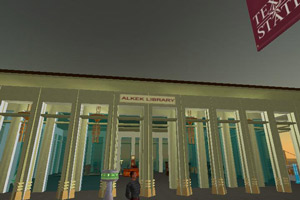Texas State on forefront of instructional technologies with Second Life island
By Maira Garcia
September 20, 2007

Alkek Library is imposing in reality.
Texas State is taking a new approach to online learning by moving it into a whole other world.
Instructional technologies, which provide technology support for the university, have been experimenting with new media to give students and professors more interactive features, particularly for distance learning courses. Second Life is capable of that, according to Emin Saglamer, the lead programmer for instructional designs team.
Second Life is a massively multiplayer online role-playing game introduced in 2003 by Linden Lab, which has been compared to Maxis’ The Sims, but much more advanced. Users or residents create everything from buildings to the clothes they wear. Residents purchase land or islands to live on and create from there. In essence, it is another world where people can live other lives if they wish, but some are choosing to integrate first life, as the real world is called among users, with Second Life.
“I was constantly saying other institutions are doing stuff with Second Life,” Saglamer said. “Other educational institutions are setting up islands for conducting classes and doing experiments. We should get involved.”
Saglamer said once his boss – Milt Nielsen, vice president for instructional technologies support – saw the capabilities of Second Life when the New Media Consortium, an organization that explores new media and technologies for education, released its island, everyone was convinced. Texas State began a Second Life island in late 2006, which is undergoing constant modification for future use.

In Second Life, Alkek is intended to do the
same,
although in a different
style.
“Since then, NMC has actually grown into a multi-sim continent and they’re actually forming an educational continent with other universities like Princeton, Cornell, Harvard – all the big names have already joined the continent,” he said. “We are in the process of being moved over there. It’s more complex than it sounds. It’s actually a very simple operation when you get to it, but all these permissions have to be acquired because we end up neighboring other university sims.”
Catherine Smith, director of marketing at Linden Lab, said since Second Life residents create all the content, it is up to them what is included. Education was something they were able to integrate.
“The potential for interaction, education, ecommerce and entertainment in a 3D environment is far greater than in the flat two-dimensional world we are now familiar with on the Web,” Smith said. “It’s possible to foresee a time when everyone on the Internet has an avatar and an address in Second Life. Just in the same way as they have adopted blogs and Web sites now.”
Not only is Second Life more interactive than other education technology tools, it’s cheaper as well, according to Saglamer.
“Compared to some of the other infrastructures we pay for at Texas State, getting an island is actually quite, quite cheap,” he said. “We’re talking about $1500 or less up front and then $150 monthly.”
A reading class is already lined up for the Spring semester, but kinks are still being worked out.
“A lot of courses you find at Texas State are hybrids. They’re face to face, but with some online component,” Saglamer said. “What we put together is very intensive. It’s all online, so it all has to work.”
While better teaching methods is the focus of introducing Second Life at Texas State, Saglamer said he is trying to five the university a nice face for interested outsiders.
“What I tried to do, instead of replicating building one by one, and heaven knows our campus has some beautiful building and not so beautiful,” he said. “I took the artistic liberty to just say I kind of have a sense of what it looks like in real life. Let’s just make this campus what it could have been if we had all the funds in the world.”
